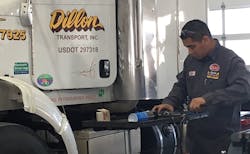Preventive maintenance can keep those rising costs down
Preventive truck maintenance can be the difference between replacing a $10 part in your shop and paying hundreds more to tow a broken-down tractor to another shop to pay someone else to replace the same part.
Fleet maintenance costs have risen 50% over the past year. But what if you knew in advance what problems your truck was bound to face so you could be prepared?
Preventive maintenance can save fleets money thanks to technology advances that let you know of potential problems before they become costly problems. Capitalizing on volumes of data, predictive maintenance algorithms keep tractors and trailers rolling smoothly between regularly scheduled shop visits and avoid pending part and system failures.
Fleet Owner hosted a webinar on Wednesday, Feb. 28, with preventive maintenance experts Greg Peck, a senior product manager with asset maintenance solutions for TMW Systems, and Russ McKusick, a warranty manager for Bozzuto’s Inc., a wholesale distributor of food and household products. The free webinar, Predictive Maintenance 201: Beyond Prevention, was sponsored by TMW.
Before truck engines were equipped with electronic control modules (ECM), you had to wait until there was a problem to do anything about an engine problem, according to Peck.
“Then we got smarter and the trucks got smarter, too,” Peck said. “They started adding the ECMs so we could diagnose problems with the code reader and troubleshooting guides. We expanded our preventative maintenance schedules to include more items to check all in the hopes of lowering our future repair costs and extending our equipment life.”
Now, Peck said, the industry is getting into a “predictive mode – where we can tell what is going to happen before it happens.”
The ECM can help solve truck problems before they happen. TMW’s TMT Predict Fault Codes software sends your maintenance department the assigned equipment, VIN (vehicle identification number), chance of failure percentage, diagnostic code and description and probability triggers.
This helps managers make informed decisions such as where to do the maintenance – in-house or outsource it – and helps you be prepared with the right parts on hand. It is a lot less expensive to change a part before it breaks than after, Peck noted.
“PMs are more than just a checklist,” Peck said of preventative maintenance. “You'll be doing a thorough inspection and, I believe, spending all your maintenance dollars at PM time is more effective than spending any money at all if I don’t have to between PMs.”
A benefit of the ELD mandate is that most fleets now getting their eDVIR (electronic Driver Vehicle Inspection Report) through truck telematics devices, Peck said. You can flow the eDVIR report into inspection tickets. Your mechanic can create a repair order before the truck is even back from its route.
Peck shared these preventive maintenance goals:
- Extend component life
- Reduce failures and breakdowns
- Schedule maintenance
- Minimize downtown
- Compliance with manufacturer and regulatory requirements
- Regulate your maintenance expense
Preventive maintenance is not just about the technicians in your shop, it is a driver's responsibility too, according to McKusick, warranty manager of Bozzuto’s. He said his fleet requires drivers to do a vehicle inspection report on an e-tablet before heading out on the road.
“So they would log in, pull up an inspection ticket and we’d have a whole list of information and a whole list of components we wanted them to check in tractor and trailer before that driver would roll out,” McKusick said. “That worked out very well, and lowered our CSA score because we were able to find things before [the driver] actually hit the street."
While the ECM (also known as an ECU) can help fleets use preventive maintenance to keep their trucks from breaking down on the road, not everyone is there yet. Although the use of ECMs is growing, here are some industry trends from TMW:
- ECM use has tripled in Class 6-8 trucks since 2006
- 15% increase in faults since 2013
- 57% of heavy-duty vehicles still have active issues after leaving the service bay
- 8% of faults will sideline a vehicle
- A heavy-duty vehicle produces an average of 2.6 faults each week.
And those unchecked faults can be costly.
“When you look at that truck downtime, at least on our side, you have to consider that you’re bringing in a service rider, the driver himself is down, the truck is down,” McKusick said. “And then most times you are bringing in people in transportation, customer service is involved contacting stores. You take all these people that because of this breakdown are now involved in it, they are not doing what they normally would do on their job. So if you can eliminate these breakdowns it just goes smoother.
Proactive maintenance/repairs benefits:
- Reduction of equipment downtime
- Identify and prioritize the trucks that require service
- Reduce road breakdown events
- Lower service and towing expenses
- Reduce cascading damage
- An out-of-service vehicles cost fleets $850-$1,000 per day, according to industry estimates
- Addressing 35% of predictions could save a fleet up to $490 per truck per year
- Better customer service and on-time performance
If you missed Fleet Owner’s webinar this week, you can listen to it for free on-demand later this week.
About the Author
Josh Fisher
Editor-in-Chief
Editor-in-Chief Josh Fisher has been with FleetOwner since 2017. He covers everything from modern fleet management to operational efficiency, artificial intelligence, autonomous trucking, alternative fuels and powertrains, regulations, and emerging transportation technology. Based in Maryland, he writes the Lane Shift Ahead column about the changing North American transportation landscape.


